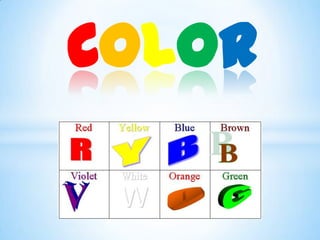
Color
- 1. COLOR
- 2. COLOR The element of art derived from reflected or absorbed light. Color adds interest and mood to a work of art. An element of art made up of three properties: • Hue: name of color • Value: hue’s lightness and darkness Lighter values are created by adding white to a color which is called the TINTS. Darker values are created by adding black to a color which is called the SHADES. • Intensity: quality of brightness and purity High intensity= color is strong and bright; Low intensity=color is faint and dull
- 3. COLOR WHEEL The color wheel was developed by Sir Isaac Newton by taking the color spectrum and bending it into a circle. The color wheel is made up of three different types of colors- Primary, Secondary, and Tertiary.
- 4. PRIMARY COLORS The primary colors are red, yellow, and blue. They are called primary for a couple of reasons. First, no two colors can be mixed to create a primary color. In other words, primary colors can only be created through the use of natural pigments. Secondly, all other colors found on the color wheel can be created by mixing primary colors together.
- 5. EXAMPLES 1. Relational Painting No. 64, 1953 by Fritz Glarner 2. Stepping Out by Roy Lichtenstein
- 6. The secondary colors are Tertiary colors are created by mixing orange, green, and equal parts of a secondary color and a purple. Secondary colors are primary color together. created by mixing equal parts of any two primary colors. YELLOW + ORANGE = YELLOW- ORANGE YELLOW + RED = ORANGE RED + ORANGE = RED-ORANGE RED + BLUE = VIOLET / PURPLE RED + VIOLET / PURPLE = RED-PURPLE BLUE + YELLOW = GREEN BLUE + VIOLET / PURPLE = BLUE- PURPLE BLUE + GREEN = BLUE-GREEN YELLOW + GREEN = YELLOW-GREEN
- 7. Color Harmonies Complementary Monochromatic harmony — is Analogous harmony — harmony — is achieved otherwise referred to as one-mode means a combination of by a combination of any or one hue harmony. It combines two or more neigh boring opposite colors in the different intensities or values - colors in the color chart. color wheel. Blue and lightness and darkness or violet, for instance, are brightness and dullness - of one complementary colors. color only. Examples are blue, light blue, dark blue.
- 8. Color Harmonies Triad Split-Complementary Rectangle (tetradic) A triadic color scheme uses The split-complementary The rectangle or colors that are evenly color scheme is a variation tetradic color scheme spaced around the color of the complementary color uses four colors wheel. scheme. In addition to the arranged into two base color, it uses the two complementary pairs. Triadic color harmonies tend colors adjacent to its to be quite vibrant, even if complement. This rich color scheme you use pale or unsaturated offers plenty of versions of your hues. possibilities for variation.
- 9. Warm colors- colors that are usually associated with warm things. Ex. Red, yellow, orange Cool colors- colors that are usually associated with cool things. Ex. Blue, purple, green
- 10. NEUTRAL COLORS
- 11. EXAMPLES Morning on the Seine near Woman Rocking a Cradle Giverny by Claude Monet by Vincent van Gogh Analogous Painting Complementary Painting
- 12. THE RGB MODEL Red, green, and blue are the primary stimuli for human color perception and are the primary additive colors. The secondary colors of RGB, cyan, magenta, and yellow, are formed by the mixture of two of the primaries and the exclusion of the third. Red and green combine to make yellow, green and blue make cyan, blue and red make magenta. The combination of red, green, and blue in full intensity makes white. White light is created when all colors of the EM spectrum converge in full intensity.
- 13. THE CMYK MODEL (Cyan-Magenta-Yellow-Black) It is a subtractive color model, used in color printing,. Cyan, magenta, and yellow correspond roughly to the primary colors in art production: red, blue, and yellow. Black results from a full combination of colored inks The CMYK model works by partially or entirely masking colors on a lighter, usually white, background. The ink reduces the light that would otherwise be reflected. Such a model is called subtractive because inks "subtract" brightness from white.
- 14. DIFFERENCE
